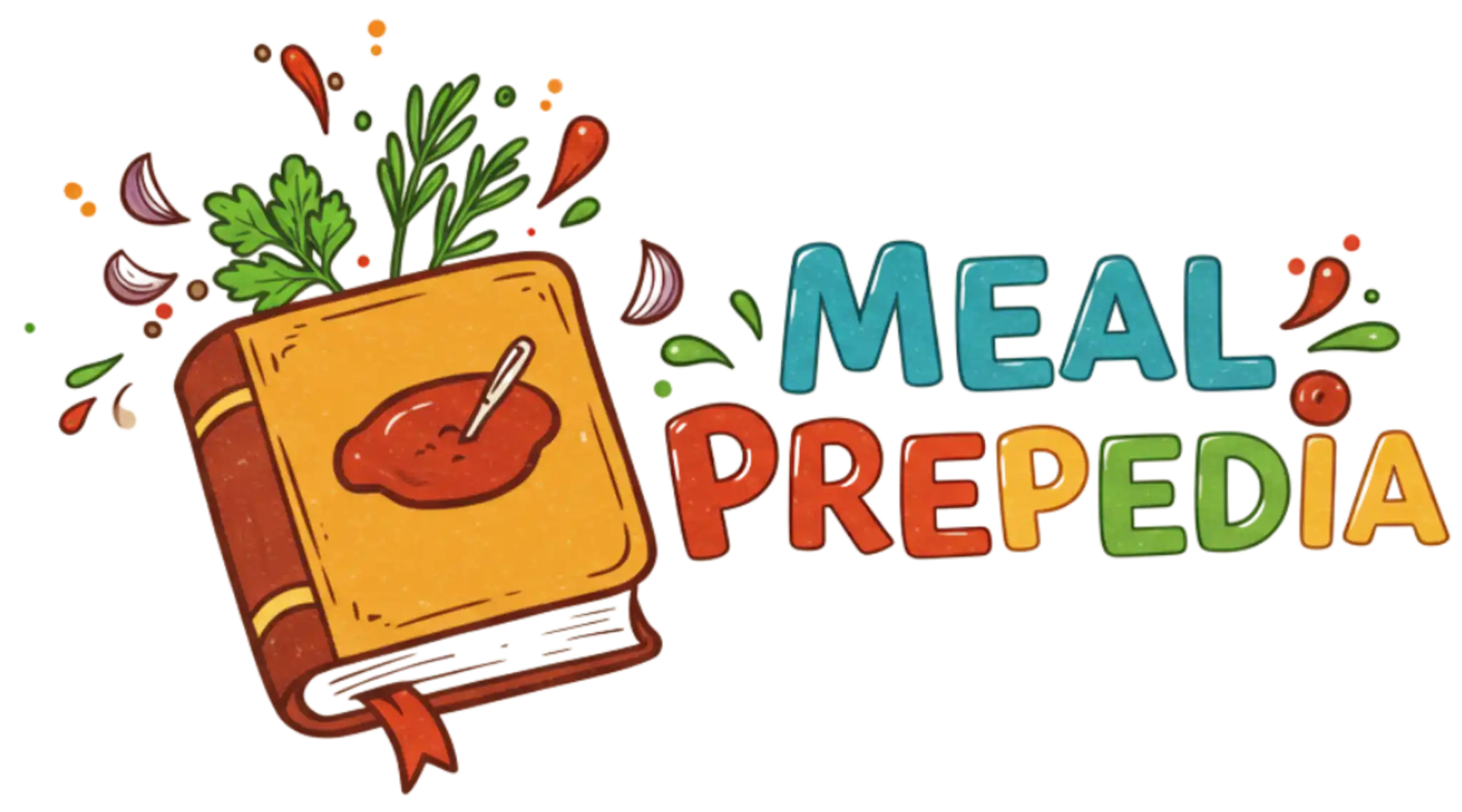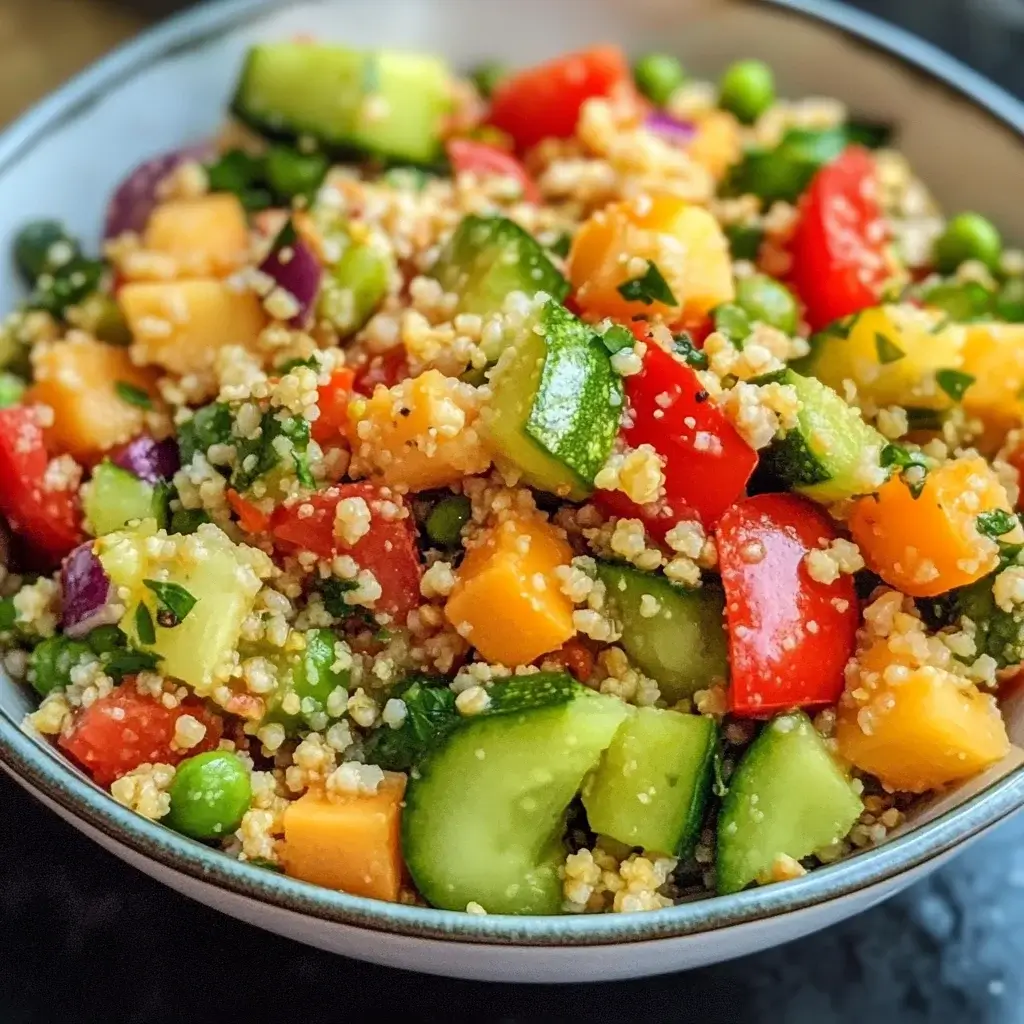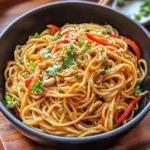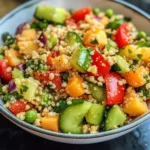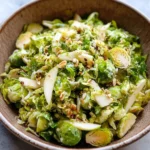Our kitchen has seen its fair share of culinary experiments, some triumphant, others… well, let’s just say they were learning experiences. But recently, we stumbled upon a creation that has unanimously been voted a family champion: the Bulgur Wheat and Veggie Vegetarian Bowl. It all started on a busy weeknight when I was craving something hearty yet healthy, vibrant but not overly complicated. My eldest, usually a staunch critic of anything too “green,” surprised me by asking for seconds, praising the “nice chewy bits” (the bulgur, of course!) and the “zesty sauce.” My partner, who appreciates a well-balanced meal that doesn’t skimp on flavor, declared it a “keeper.” What truly makes this recipe a star in our household is its incredible versatility and the way it brings a burst of freshness to the table. It’s become our go-to for a quick lunch, a satisfying dinner, and even a colorful contribution to potlucks. The combination of nutty bulgur, crisp-tender vegetables, protein-packed chickpeas, and a bright, tangy dressing is simply irresistible. It’s a dish that not only nourishes the body but also delights the senses, proving that healthy eating can be an exciting and delicious adventure. This Bulgur Wheat and Veggie Vegetarian Bowl isn’t just food; it’s a vibrant celebration of wholesome ingredients coming together in perfect harmony.
Ingredients
- 1 cup Bulgur Wheat (medium or coarse grind): This quick-cooking whole grain forms the hearty, nutty base of our bowl.
- 2 cups Vegetable Broth or Water: Used for cooking the bulgur, imparting subtle flavor if using broth.
- 1 tablespoon Olive Oil: For sautéing the vegetables and adding a touch of healthy fat.
- 1 Red Onion (medium, thinly sliced): Adds a pungent sweetness and beautiful color.
- 2 Cloves Garlic (minced): For that aromatic, foundational flavor.
- 1 Red Bell Pepper (cored, seeded, and diced): Brings sweetness, crunch, and a vibrant red hue.
- 1 Yellow Bell Pepper (cored, seeded, and diced): Adds another layer of sweet pepper flavor and bright color.
- 1 Zucchini (medium, diced): Provides a tender bite and subtle, fresh flavor.
- 1 cup Cherry Tomatoes (halved): Bursts of juicy sweetness that complement the other veggies.
- 1 can (15 ounces) Chickpeas (rinsed and drained): A fantastic source of plant-based protein and fiber.
- 1/2 cup Fresh Parsley (chopped): For a fresh, herbaceous lift.
- 1/4 cup Fresh Mint (chopped, optional): Adds a cool, refreshing note, particularly lovely in warmer months.
- For the Lemon-Herb Vinaigrette:
- 1/4 cup Extra Virgin Olive Oil: The rich, fruity base of our dressing.
- 3 tablespoons Lemon Juice (freshly squeezed): Provides essential brightness and acidity.
- 1 teaspoon Dijon Mustard: Helps to emulsify the dressing and adds a tangy depth.
- 1/2 teaspoon Dried Oregano: A classic Mediterranean herb that pairs wonderfully with the vegetables.
- Salt and Black Pepper to taste: To season and enhance all the flavors.
- Optional Garnish: Crumbled feta cheese (if not strictly vegan), toasted pumpkin seeds, or a dollop of hummus.
Instructions
- Cook the Bulgur Wheat: In a medium saucepan, bring the vegetable broth or water to a boil. Add the bulgur wheat, stir once, then reduce the heat to low. Cover the saucepan and let it simmer for 12-15 minutes, or until all the liquid has been absorbed and the bulgur is tender. Once cooked, fluff the bulgur with a fork and set aside, covered, to keep warm. This step is crucial for achieving that perfect, slightly chewy texture that makes bulgur so satisfying.
- Sauté the Aromatics: While the bulgur is cooking, heat 1 tablespoon of olive oil in a large skillet or wok over medium heat. Add the thinly sliced red onion and cook for 3-4 minutes until it begins to soften and become translucent. Add the minced garlic and cook for another minute until fragrant, being careful not to burn it. This initial sauté builds a foundational layer of flavor for our veggie bowl.
- Cook the Vegetables: Add the diced red and yellow bell peppers and diced zucchini to the skillet. Sauté for 5-7 minutes, stirring occasionally, until the vegetables are crisp-tender. You want them to retain a bit of their bite, not become mushy. The vibrant colors will start to intensify, making the dish visually appealing.
- Incorporate Chickpeas and Tomatoes: Add the rinsed and drained chickpeas and the halved cherry tomatoes to the skillet. Cook for another 2-3 minutes, just until the chickpeas are heated through and the tomatoes begin to soften slightly. The warmth will help the tomatoes release some of their sweet juices.
- Prepare the Lemon-Herb Vinaigrette: While the vegetables are finishing, prepare the dressing. In a small bowl or a jar with a lid, whisk together the extra virgin olive oil, freshly squeezed lemon juice, Dijon mustard, and dried oregano. Season generously with salt and black pepper to your preference. Taste and adjust seasoning if necessary – perhaps a little more lemon for tartness or a pinch more salt to make the flavors pop.
- Combine and Season: Once the bulgur wheat is cooked and fluffed, add it to the large skillet with the sautéed vegetables and chickpeas. Pour the prepared Lemon-Herb Vinaigrette over the mixture. Add the chopped fresh parsley and mint (if using). Gently toss everything together until well combined and the bulgur and vegetables are evenly coated with the dressing.
- Serve: Divide the Bulgur Wheat and Veggie Vegetarian Bowl among individual serving bowls. If desired, garnish with crumbled feta cheese, toasted pumpkin seeds for extra crunch, or a dollop of creamy hummus for added richness. Serve warm and enjoy this nutritious and flavorful meal.
Nutrition Facts
- Servings: 4
- Calories per serving: Approximately 450-500 kcal (This can vary based on exact ingredient sizes and optional garnishes)
- Fiber: High in dietary fiber, primarily from the bulgur wheat, vegetables, and chickpeas, promoting digestive health and satiety.
- Protein: A good source of plant-based protein, essential for muscle repair and overall bodily functions, thanks to the bulgur and chickpeas.
- Vitamins & Minerals: Rich in various vitamins (like Vitamin C from bell peppers and tomatoes, B vitamins from bulgur) and minerals (like iron and magnesium), supporting overall well-being.
- Healthy Fats: Contains monounsaturated fats from olive oil, which are beneficial for heart health.
- Complex Carbohydrates: Provides sustained energy release due to the complex carbohydrates in bulgur wheat, preventing energy crashes.
Preparation Time
- Total Preparation Time: Approximately 35-45 minutes
- Prep Time (Chopping & Measuring): 15-20 minutes – This involves washing and chopping all the fresh vegetables, measuring out the bulgur and dressing ingredients. Efficient chopping can speed this up.
- Cook Time (Bulgur & Sautéing): 20-25 minutes – This includes the simmering time for the bulgur wheat and the sautéing time for the vegetables and aromatics. These can often be done concurrently to save time.
How to Serve
This Bulgur Wheat and Veggie Vegetarian Bowl is incredibly versatile. Here are some delightful ways to serve and enjoy it:
- As a Standalone Main Course:
- Serve warm in individual bowls for a complete and satisfying vegetarian or vegan meal.
- Its balance of whole grains, protein, and vegetables makes it a perfect one-dish wonder for lunch or dinner.
- Enhanced with Toppings:
- Dairy/Vegan Cheese: A sprinkle of crumbled feta cheese adds a salty, creamy tang. For a vegan option, use a good quality vegan feta alternative or a sprinkle of nutritional yeast for a cheesy flavor.
- Nuts and Seeds: Toasted pumpkin seeds, sunflower seeds, or chopped almonds add a delightful crunch and extra nutrients.
- Fresh Herbs: Beyond the parsley and mint in the recipe, a little extra fresh dill or cilantro can offer a different aromatic profile.
- Sauce Drizzle: A dollop of hummus, tahini sauce, or a spicy harissa yogurt (or vegan yogurt) on top can elevate the flavors and textures.
- For Meal Prepping:
- Cook the bulgur and vegetables separately and store them in airtight containers in the refrigerator.
- Keep the dressing in a separate small container.
- Combine and dress just before serving to maintain the freshness and crunch of the vegetables. This makes for fantastic grab-and-go lunches throughout the week.
- As a Hearty Side Dish:
- Serve smaller portions alongside grilled halloumi, baked fish, or roasted chicken for those who aren’t strictly vegetarian.
- It pairs wonderfully with Mediterranean-inspired main courses.
- In Lettuce Cups or Wraps:
- For a lighter, low-carb option, scoop the bulgur and veggie mixture into large lettuce leaves (like romaine or butter lettuce) to create fresh wraps.
- It can also be used as a filling for pita bread or whole wheat tortillas.
- For Potlucks and Gatherings:
- This dish travels well and is always a crowd-pleaser due to its vibrant colors and universally appealing flavors.
- It can be served warm or at room temperature, making it convenient for buffet-style settings.
- As a Base for Other Proteins:
- While already protein-rich with chickpeas, you can easily add pan-fried tofu cubes, tempeh, or even a fried egg on top for an extra protein boost.
Additional Tips
- Vary Your Veggies: Don’t feel limited by the vegetables listed! This bowl is a fantastic way to use up whatever you have in your fridge. Try adding roasted eggplant, sautéed mushrooms, steamed broccoli florets, corn, or even some leafy greens like spinach or kale (stir them in at the end until just wilted). Seasonal vegetables will always offer the best flavor.
- Boost the Protein: While chickpeas are great, you can amp up the protein content further. Consider adding cooked lentils (green or brown), black beans, edamame, or even some crumbled firm tofu or tempeh sautéed with the other vegetables. For non-vegetarians, grilled chicken or shrimp would also be delicious additions.
- Spice it Up or Down: Adjust the heat and spice level to your liking. A pinch of red pepper flakes added with the garlic can give a nice kick. Smoked paprika can add a lovely smoky depth. For a different flavor profile, try adding a teaspoon of cumin or coriander to the vegetables while they sauté.
- Herbaceous Heaven: Fresh herbs make a huge difference. Besides parsley and mint, consider using fresh dill for a more distinct Mediterranean flavor, or cilantro if you’re leaning towards a more Middle Eastern vibe. If fresh herbs aren’t available, use dried, but remember to use about one-third the amount of dried herbs as fresh.
- Bulgur Wheat Know-How: For a nuttier flavor, you can toast the dry bulgur wheat in the saucepan for a couple of minutes before adding the broth or water. Make sure you’re using medium or coarse grind bulgur; fine grind is typically used for tabbouleh and might become mushy if cooked this way.
- Dressing Customization: The lemon-herb vinaigrette is classic, but feel free to experiment. A tahini-based dressing would also be wonderful. You could also add a touch of maple syrup or agave to the vinaigrette for a hint of sweetness to balance the acidity.
- Make it Ahead for Meal Prep: This bowl is excellent for meal prepping. Cook the bulgur and the vegetable mixture separately and store them in airtight containers in the fridge for up to 4 days. Keep the dressing separate and toss everything together just before serving to maintain the best texture.
- Don’t Overcook the Veggies: Aim for crisp-tender vegetables. They should still have a bit of a bite. Overcooking will make them mushy and less appealing, and can also diminish their nutritional value. Sautéing over medium-high heat helps them cook quickly while retaining some crunch.
FAQ Section
Q1: What exactly is bulgur wheat, and where can I find it?
A: Bulgur wheat is a whole wheat grain that has been cracked, parboiled (or partially cooked), and then dried. This pre-cooking process means it cooks much faster than other whole wheat grains like wheat berries. It has a pleasant, nutty flavor and a chewy texture. You can typically find bulgur wheat in the grains aisle of most supermarkets, often near rice and quinoa, or in Middle Eastern or health food stores. It’s available in different grinds: fine, medium, and coarse. For this recipe, medium or coarse grind is recommended.
Q2: Is this Bulgur Wheat and Veggie Vegetarian Bowl gluten-free?
A: No, this recipe is not gluten-free because bulgur wheat is made from wheat, which contains gluten. If you need a gluten-free alternative, you can substitute the bulgur wheat with an equal amount of cooked quinoa, brown rice, millet, or even cauliflower rice for a lower-carb option. Adjust cooking times according to the grain you choose.
Q3: Can I make this recipe vegan?
A: Yes, this recipe is easily made vegan! The core ingredients – bulgur, vegetables, chickpeas, and the lemon-herb vinaigrette – are naturally vegan. The only modification needed is to omit the optional garnish of feta cheese or ensure you use a plant-based feta alternative if you desire that salty, briny flavor.
Q4: How long will this vegetarian bowl last in the refrigerator?
A: Stored properly in an airtight container, the assembled Bulgur Wheat and Veggie Vegetarian Bowl will last for 3-4 days in the refrigerator. If you’re meal prepping, it’s best to store the cooked bulgur, sautéed vegetables, and dressing in separate containers and combine them just before serving to maintain the best texture, especially for the vegetables.
Q5: Can I use a different type of grain instead of bulgur wheat?
A: Absolutely! While bulgur gives it a traditional Mediterranean feel, you can easily substitute it with other grains. Quinoa would be a great gluten-free, high-protein option. Farro would offer a similarly chewy texture. Couscous (especially pearl couscous) or even orzo pasta could also work, though cooking times and liquid ratios will vary. Brown or white rice are also viable alternatives.
Q6: What if I don’t have all the specific vegetables listed in the recipe?
A: This recipe is highly adaptable! Feel free to use other vegetables you have on hand or prefer. Good substitutes or additions include broccoli florets, cauliflower, carrots (diced or shredded), mushrooms, eggplant, sweet potatoes (roasted separately), snap peas, or even frozen peas (added towards the end). The key is to aim for a colorful and texturally diverse mix.
Q7: Is this recipe suitable for meal prep for lunches during the week?
A: Yes, it’s perfect for meal prep! As mentioned, cook the bulgur and the vegetable-chickpea mixture. Store them in separate containers in the fridge. The dressing can also be made ahead and stored in a small jar. When ready to eat, simply combine the components in a bowl. This keeps everything fresh and prevents the bulgur from becoming soggy or the veggies from losing their crunch too quickly.
Q8: What makes this Bulgur Wheat and Veggie Vegetarian Bowl a healthy choice?
A: This bowl is packed with nutritional benefits!
- Whole Grains: Bulgur wheat provides complex carbohydrates for sustained energy and is a good source of dietary fiber.
- Plant-Based Protein: Chickpeas and bulgur contribute significant plant-based protein, essential for muscle health and satiety.
- Vitamins and Minerals: The variety of colorful vegetables offers a wide array of vitamins (like A, C, K) and minerals.
- Healthy Fats: Olive oil in the sautéing process and dressing provides heart-healthy monounsaturated fats.
- Fiber-Rich: The combination of grains, legumes, and vegetables makes it very high in fiber, which is crucial for digestive health, blood sugar regulation, and can help with weight management by promoting fullness.
It’s a well-rounded, nutrient-dense meal that supports a healthy lifestyle.
